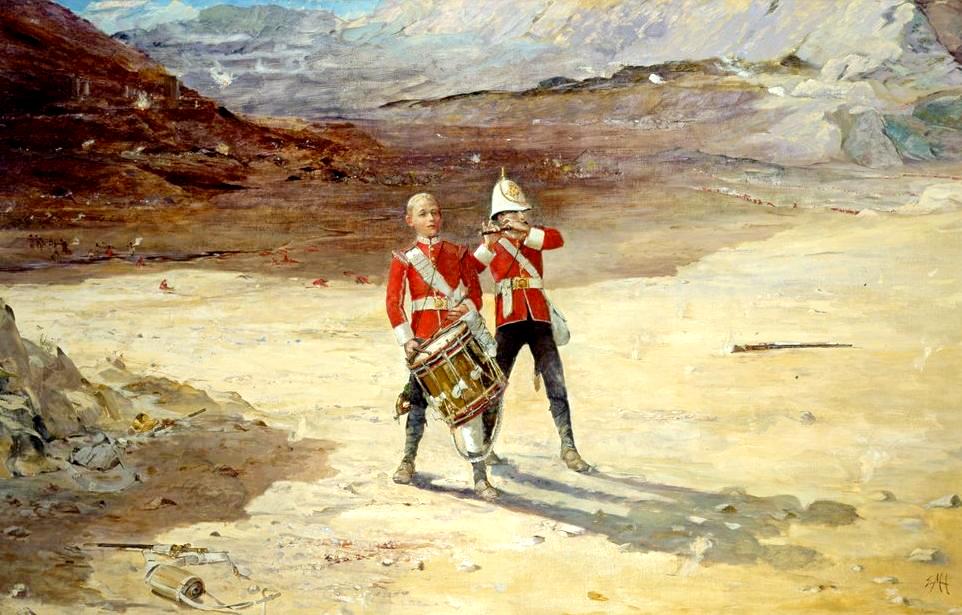
Afghanistan History: The Great Game (1813-1907)

Figure 1.-- This is Edward Matthew Hale’s 1895 painting, 'The Drums of the Fore and Aft'. Hale was the war artist for the 'Illustrated London News'. At the time photograksIt depicts the 1880 Battle of Ahmed Khel in the Second Afghan War. The weapons discarded in the painting show the rifles discarded bu a retreating British army, mostly Indian regiments. There were 7,200 Anglo-Indian troops pitted against 15,000 Afghanistan tribal warriors. Gen. Donald Stewart troops marched from Kandahar to Kabul Ghazni. It was while the soldiers were en-route to Kabul that the battle took place. The painting shows a rather glorified image of "The two little red dots ... in the open, parallel to the enemy's front".
Apparently an inadequately trained British regiment is sent forward in a border engagement anf encountered a fanatical group Muslim fighters, 'powerful hairy men' armed with long knives. The British were driven back and retreat in panic and confusion, but two young drummer boys, Jakin and Lew, refuse to withdraw. They march back and forth to the strains of "The British Grenadiers". The regiment turns back and advances on the enemy, this time successfully. The boys are killed, but the battle was won. One source maintains that this story is founded on fact, and that the fight in the story is probably an amalgamation of the disastrous British defeat at Maiwand, the victory at Ahmed Khel during the 2nd Afghan War (1878-1890).
|
|
The 19th century found Afghanistan as the center of the 'Great Game' pitting the Russians in Central Asia with the British in India. Also part part of the Great Game was Islamic findamentalism in Afghanistan. Many royal regimes appeared in Afganistan which both welcomed the British and delivered disastrous military defeats. Much of the subsequent history of Afganistan has been the tension between western reformers and Islamaic fundamentalists. This was a major factor in Afgahani developments which fed into the quarelsome Northwest Frontier area of the Raj.
More than one Afgani king (emir) has been deposed and killed by the fundamentalists. The two most important events of the Graat Game were the First and Second Anglo-Afghan Wars. The British controlling India, sought to expand its control over neighbouring Afghanistan tonthe north and to oppose increasing Russian influence there. A protracted Agahni civil war broke out (1816). The Bārakzay clan emerged as the ruling dynasty. The clan was dominated by Dōst Moḥammad Khan who who seized the throne (1826). Britain and Russia maneuvered for influence. Dōst Moḥammad was attempted to balance Afghanistan between the influence of the great powers. The British concluded that Dōst Moḥammad was basically hostile to them or at least unable to resist Russian penetration. They moved to take a direct role in Afghan affairs. They attempted to negotiate Dōst Moḥammad, but finally Governor-General of India, Lord Auckland, ordered an invasion of Afghanistan to restore exiled Afghan ruler Shah Shojāʿ to the throne. The result was the first Adghan War (1839-42). Three decades later, relations flared up again as the British wrestled withbthe issues of empire. It was a primary issue in the decades-long struugle between Queen Victoria favorite Benjamin Disraeli and William Gladstone. Disraeli was an empire builder. He appointed Lord Lytton to the office of Governor-General of India (1875). Lytton during became concerned primarily with India’s relations with Afghanistan. Russian influence was growing in Central Asia, including Afghanistan. This was growing concern to the British Government and Lytton had ordered resit this or at least to establish a strong border frontier, by force if necessary. Thus Lytton after arriving in India, informed Emir Shīr ʿAlī Khan—the third son of Dōst Moḥammad, who had risen to the throne when his father died, that he was sending a mission to Kabul. The Emir refused to allow Lytton's mission permission to enter Afghanistan. Lytton was furious. He dismissively exclaimed that Afghanistan was but 'an earthen pipkin between two metal pots'. He did not, however, act immediately. This changed when the Emir allowed a Russian mission headed by General Stolyetov to enter Kabul (1878). Lytton’s mission headed by Sir Neville Chamberlain was refused entry at the border by Afghan troops. Ths result was the Second Afghan War (1878-80). Eventually British and Afghani diplomats agreed to a boundary which became known as the Durand Line (1893). It created a long 2,640 kilometers (1,640 mi) and porous border. The Durand Line was agreed to by Mortimer Durand from the British India and Afghan Amir Abdur Rahman Khan. It was designed to fix the border as part of a process of improving diplomatic relations and trade. Afghanistan was considered by the British as an independent princely state, one of many such states on the Indian Subcontunent and a part of the British Raj. The British as part of the Great Game controlled both its foreign affairs and diplomatic relations.
HBC

Related Chronolgy Pages in the Boys' Historical Web Site
[The 1880s]
[The 1890s]
[The 1900s]
[The 1910s]
[The 1920s]
[The 1930s]
[The 1940s]
[The 1930s]
[The 1940s]
[The 1950s]
[The 1960s]
[The 1970s]
[The 1980s]
Related Style Pages in the Boys' Historical Web Site
[Long pants suits]
[Knicker suits]
[Short pants suits]
[Socks]
[Eton suits]
[Jacket and trousers]
[Blazer]
[School sandals]
[School smocks]
[Sailor suits]
[Pinafores]
[Long stockings]
Navigate the Boys' Historical Clothing Web Page
[Return to the Main Great Game page]
[Return to the Main Afghan history page]
[Return to the Main Afghan military page ]
[Return to the Main Cold War country page]
[Return to the Modern Afghani history]
[Return to the Main Afghan country page]
[Return to the Main Asian history page]
[Return to the Main Middle Eastern human rights page]
[About Us]
[Introduction]
[Biographies]
[Chronology]
[Climatology]
[Clothing]
[Disease and Health]
[Economics]
[Freedom]
[Geography]
[History]
[Human Nature]
[Ideology]
[Law]
[Nationalism]
[Presidents]
[Religion]
[Royalty]
[Science]
[Social Class]
[Bibliographies]
[Contributions]
[FAQs]
[Glossaries]
[Images]
[Links]
[Registration]
[Tools]
[Children in History Home]
Created: 5:39 AM 11/21/2013
Last updated: 6:06 AM 4/17/2019



